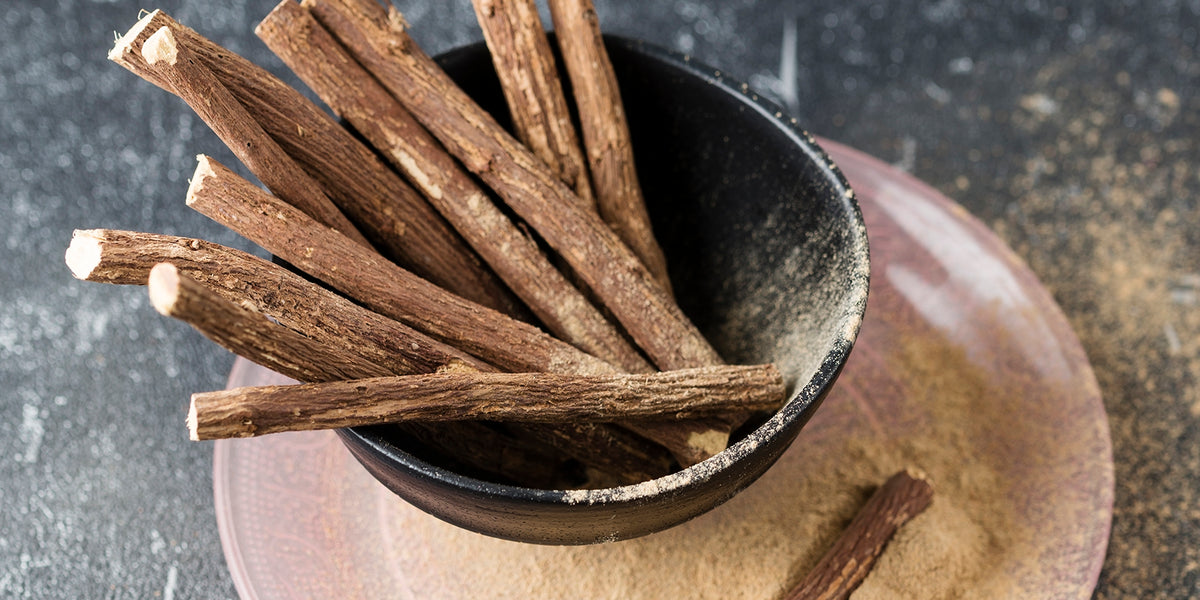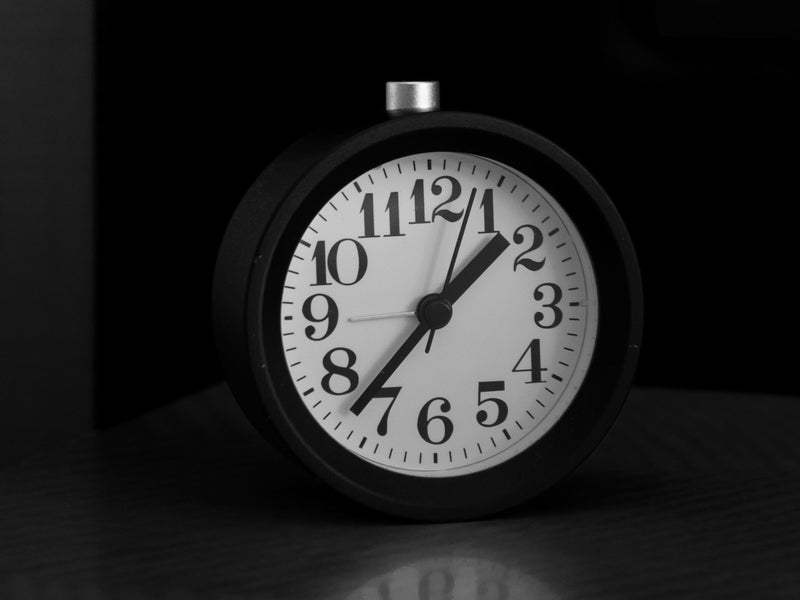Licorice Root for a Less Painful (and Plant-Powered) Period
Our relationship to our periods often shifts over our lifetimes, with lots of valid and varying ways to feel about them. There’s the early embarrassment of “Aunt Flo” arriving during gym class. Then the times we practically prayed for it to come (and on time, please!) after a sexual encounter. Maybe you’ve crossed your fingers for it to stay away while hoping for a pregnancy. Now with perimenopause, many of us don’t know how to feel about or what to expect from our newly erratic periods.
However you feel about your period, the time leading up to its inevitable conclusion does not have to be painful or unnecessarily wild. That’s why we included licorice root in our 40+ Period Support, one of our supplements to balance hormones after 40.
Why We Love Licorice Root
- It’s a phytoestrogenic super star. It’s all about the hormone balance, babe. Licorice root has natural compounds that mimic estrogen, leading to better hormone balance for women over 40.
- Licorice root’s multifaceted approach to period care makes it a perfect part of our 40+ Period Support supplement. Curious about how this plant soothes period cramps, reduces period diarrhea and improves cycle regularity? Read on!
Key Benefits
Hormone Balance - Hormone balance for women over 40 is absolutely crucial, and licorice root can help. Most uncomfortable effects of perimenopause are due to shifting estrogen, progesterone and testosterone levels. Licorice root’s phytoestrogens react with estrogen receptors and reduce prostaglandins to restore hormonal equilibrium. This can seriously improve quality of life in grown women without the risky side effects associated with pharmaceutical hormone replacement therapy.
Reduce Period Cramps - During your period, molecules called prostaglandins make your uterus contract and shed its lining. Unfortunately, too many prostaglandins can make your uterus contract more than necessary, causing painful menstrual cramps. Licorice root lowers prostaglandin production to ease period pain.
Eases Period-Related Diarrhea - Look. It’s not glamorous, but we have to talk about period poop. As if causing cramps wasn’t enough, elevated prostaglandins during your period are also responsible for period diarrhea. Thankfully, licorice root helps here.
Improves Menstrual Regularity - One cause of irregular periods is an imbalance of testosterone and estrogen. Not only does licorice root emulate estrogen, it also inhibits testosterone secretion. This balances those hormones for optimal menstrual regularity.
Note: Menstrual irregularity is part of perimenopause for most (if not all) women, but women with PCOS (polycystic ovarian syndrome) can experience it during all life stages. There is lots of promising research about licorice root for PCOS, including studies indicating that it can reduce ovarian cyst growth.
Helps Fight Fatigue - Licorice root can ward off the midday slump by slowing the conversion of cortisol into cortisone. We know that cortisol has a bad rap as a stress hormone, but there’s more to the story. Cortisol levels are naturally higher in the morning, which helps you feel awake. Throughout the day, cortisol converts into cortisone. For many people, this shift causes midday fatigue. Licorice root can inhibit the enzyme that makes this conversion happen so that your cortisol sticks around for longer, leading you to feel less sleepy.
Licorice root is an optimal herb for period wellness, especially during perimenopause. Check out our Wile 40+ Period Support supplement to reap the rewards for yourself.
Traditional Uses
Licorice root’s history goes back at least to 2500 BCE, when ancient Assyrians wrote about it in their clay cuneiform tablets. Ancient Egyptians were also early adopters, with papyrus scrolls detailing its medicinal uses and its culinary power as a sweetener.
In Traditional Chinese Medicine, licorice root is used for:
- digestive support
- reducing phlegm
- cough
- pain relief
- complementing other herbs so that they work more efficiently in the body
Its uses in Ayurveda include:
- adrenal support
- to reduce inflammation
- as a mild laxative
About Licorice:
Licorice plants are native to the Middle East and the land surrounding the Mediterranean Sea. Technically a legume, it has branching green stems with fronds of green compound leaves and purple, pink or white flowers that slightly resemble clover flowers. The roots are fragrant and medicinal.
Licorice root’s latin genus name is Glycyrrhiza, which translates literally to “sweet root.” Not so incidentally, sweet root is one of this plant’s common names. Makes sense for something that features so prominently in candy shops! If you’re taking licorice root via herbal candies, just make sure they’re made with the real thing. Anise tastes similar and is used as a licorice-like flavoring but doesn’t have the same properties.
Found In:
Things to Know about Licorice Root:
While licorice root is safe for most people, it never hurts to be careful when adding a new supplement to your regimen. Talk to your doctor before use if you have a history of heart disease or high blood pressure. Licorice root may interact with some medications, so use caution if you take diuretics, steroids, or blood pressure or cholesterol medicine. Take care not to exceed the recommended dose of any licorice root supplements.
Licorice root is not safe for use during pregnancy and is discouraged during breastfeeding.
Clinical Research
- Chen, Yandi, Melissa Agnello, Márcia Dinis, Kenneth C. Chien, Jing Wang, Wei Hu, Wenyuan Shi, Xuesong He, and Jing Zou. “Lollipop Containing Glycyrrhiza Uralensis Extract Reduces Streptococcus Mutans Colonization and Maintains Oral Microbial Diversity in Chinese Preschool Children.” PLOS ONE 14, no. 8 (August 22, 2019): e0221756. https://www.ncbi.nlm.nih.gov/pmc/articles/PMC6707631/.
- Jafari, Zahra, Majid Emtiazy, Farnaz Sohrabvand, Daryush Talei, Laleh Oveidzadeh, Mahboobeh Abrishamkar, Mahshid Meyssami, and Mohammad Kamalinejad. “The Effect of Glycyrrhiza Glabra L. on Primary Dysmenorrhea Compared with Ibuprofen: A Randomized, Triple-Blind Controlled Trial.” Iranian Journal of Pharmaceutical Research 18, no. Suppl1 (December 31, 2018): 291–301. https://www.ncbi.nlm.nih.gov/pmc/articles/PMC7393041/.
- Lin, Po Ting, Yi Wai Chiang, Tzong-Ming Shieh, Hsin Chen, Chun Che Shih, Tong Wang, Kai Wang, et al. “Dietary Compound Isoliquiritigenin, an Antioxidant from Licorice, Suppresses Triple-Negative Breast Tumor Growth via Apoptotic Death Program Activation in Cell and Xenograft Animal Models.” Antioxidants 9, no. 3 (March 9, 2020): 228. https://pubmed.ncbi.nlm.nih.gov/32164337/.
- Mersereau, Jennifer E., Nitzan Levy, Richard E. Staub, Scott Baggett, Tetjana Zogric, Sylvia Chow, William A. Ricke, et al. “Liquiritigenin Is a Plant-Derived Highly Selective Estrogen Receptor β Agonist.” Molecular and Cellular Endocrinology 283, no. 1–2 (February 12, 2008): 49–57. https://www.ncbi.nlm.nih.gov/pmc/articles/PMC2277338/.
- Nahidi, F., E. Zare, F. Mojab, and H. Alavi-Majd. “Effects of licorice on relief and recurrence of menopausal hot flashes.”Iranian Journal of Pharmaceutical Research: IJPR, 11(2): 541-548. https://www.ncbi.nlm.nih.gov/pmc/articles/PMC3832176/.
- Shamsi, Maryam, Vahid Nejati, Gholamreza Najafi, and Sana Khajehpour. “Protective Effects of Licorice Extract on Ovarian Morphology, Oocyte Maturation, and Embryo Development in PCOS-Induced Mice: An Experimental Study.” Iranian Journal of Reproductive Medicine, October 9, 2020. https://www.ncbi.nlm.nih.gov/pmc/articles/PMC7569710/.
- Sabbadin, Chiara, Luciana Bordin, Gabriella Donà, Jacopo Manso, Giampiero Avruscio, and Decio Armanini. “Licorice: From Pseudohyperaldosteronism to Therapeutic Uses.” Frontiers in Endocrinology 10 (July 17, 2019). https://www.ncbi.nlm.nih.gov/pmc/articles/PMC6657287/.
- Yang, Rui, Bochuan Yuan, Yongsheng Ma, Shan Zhou, and Ying Liu. “The Anti-Inflammatory Activity of Licorice, a Widely Used Chinese Herb.” Pharmaceutical Biology 55, no. 1 (December 31, 2016): 5–18. https://www.ncbi.nlm.nih.gov/pmc/articles/PMC7012004/.
Sources
- Brighten, Jolene. “The Benefits of Licorice Root for Women.” Dr. Jolene Brighten, November 24, 2021. https://drbrighten.com/licorice-root-benefits/.
- Brighten, Jolene. “Why Do I Poop So Much On My Period?” Dr. Jolene Brighten, May 27, 2022. https://drbrighten.com/why-do-i-poop-so-much-on-my-period/.
- “Licorice Root - American Botanical Council,” n.d. https://www.herbalgram.org/resources/expanded-commission-e/licorice-root/.
- NCCIH. “Licorice Root,” n.d. https://www.nccih.nih.gov/health/licorice-root.
- Pietrangelo, Ann. “Does Menopause Affect Polycystic Ovary Syndrome (PCOS)?” Healthline, April 1, 2019. https://www.healthline.com/health/menopause/pcos-and-menopause.
- Verywell Health. “What Is Licorice Root?,” December 7, 2022. https://www.verywellhealth.com/the-benefits-of-licorice-root-89727.
This article is intended for informational purposes and is not intended to replace a one-on-one medical consultation with a professional. Wile, Inc researches and shares information and advice from our own research and advisors. We encourage every woman to research, ask questions and speak to a trusted health care professional to make her own best decisions.





